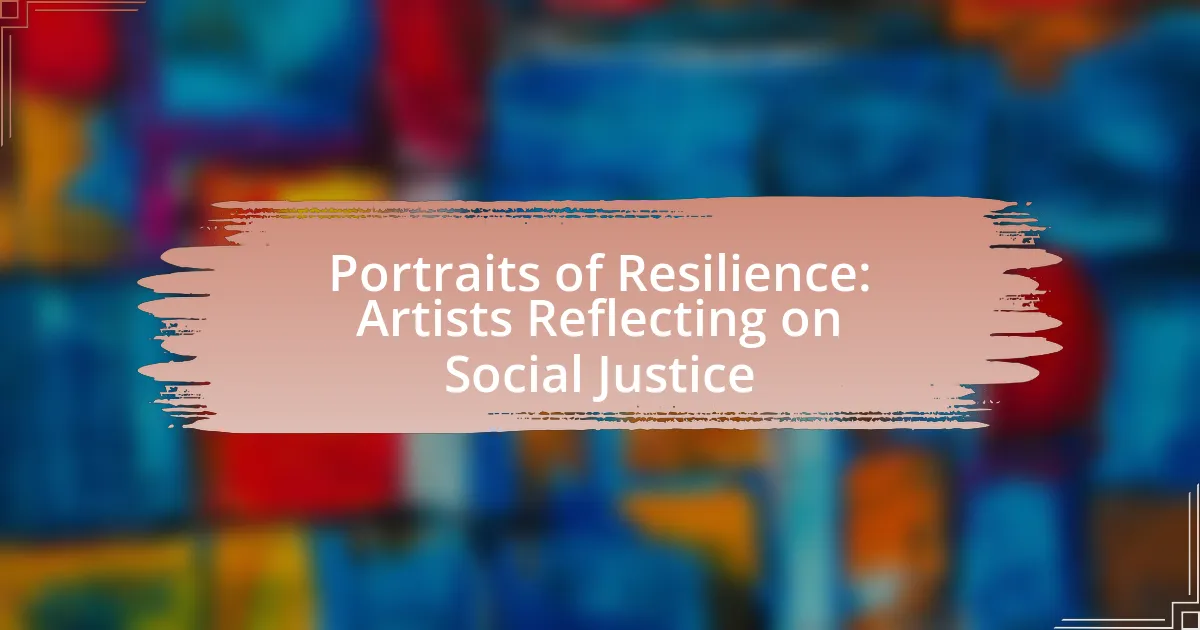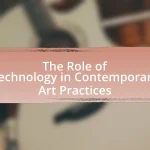Portraits of Resilience: Artists Reflecting on Social Justice focuses on artistic representations that highlight the strength and perseverance of marginalized individuals and communities facing systemic oppression. The article explores how artists utilize their work to address social justice themes, depicting issues such as racial inequality, gender discrimination, and economic disparity. It examines the influence of different artistic styles on the portrayal of resilience and discusses the role of key artists in this movement, their backgrounds, and how personal experiences shape their expressions. Additionally, the article highlights the importance of community engagement, exhibitions, and the impact of these artworks on public perception of social justice, while providing practical steps for artists and individuals to support this vital cause.
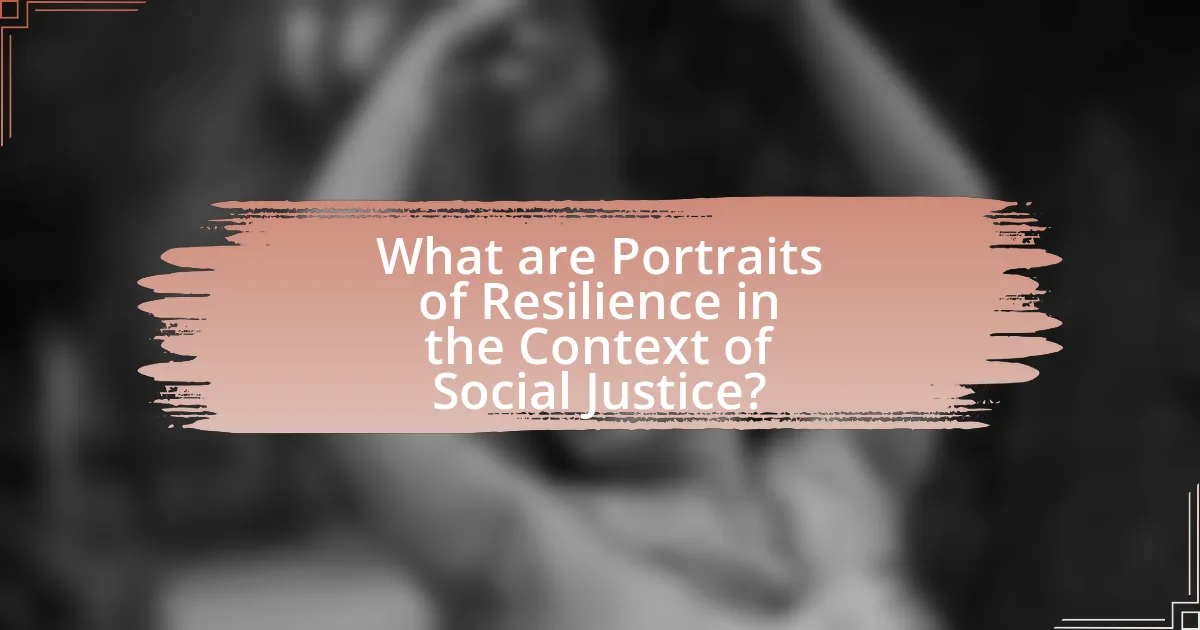
What are Portraits of Resilience in the Context of Social Justice?
Portraits of Resilience in the context of social justice are artistic representations that highlight the strength and perseverance of individuals or communities facing systemic oppression and adversity. These portraits serve to document and celebrate the lived experiences of marginalized groups, showcasing their struggles and triumphs in the pursuit of equity and justice. For example, artists may depict activists, survivors of violence, or communities overcoming socio-economic challenges, thereby providing a visual narrative that fosters empathy and awareness. This artistic approach not only amplifies the voices of those often silenced but also encourages dialogue around social justice issues, making the experiences of resilience more accessible and relatable to a broader audience.
How do artists use their work to reflect social justice themes?
Artists use their work to reflect social justice themes by addressing societal issues, raising awareness, and inspiring change through visual storytelling. For instance, artists like Ai Weiwei utilize installations and public art to comment on human rights violations, while the Black Lives Matter movement has been visually represented through murals and street art that highlight racial inequality. These artistic expressions serve as powerful tools for social commentary, often sparking dialogue and mobilizing communities around critical issues such as systemic racism, gender equality, and environmental justice. The impact of such works is evident in their ability to resonate with audiences, provoke thought, and encourage activism, thereby reinforcing the role of art as a catalyst for social change.
What specific social justice issues are commonly depicted in these portraits?
Common social justice issues depicted in these portraits include racial inequality, gender discrimination, and economic disparity. These portraits often highlight the struggles faced by marginalized communities, showcasing the impact of systemic oppression and advocating for change. For instance, artists may portray the Black Lives Matter movement to address racial injustice, or they may depict women’s rights activism to emphasize gender equality. Additionally, visual representations of poverty and homelessness serve to raise awareness about economic inequality, illustrating the urgent need for social reform.
How do different artistic styles influence the portrayal of resilience?
Different artistic styles significantly influence the portrayal of resilience by shaping the emotional and visual narratives conveyed through the artwork. For instance, realism often emphasizes the struggles and triumphs of individuals, capturing raw emotions and authentic experiences that resonate with viewers, thereby fostering a deeper understanding of resilience in the face of adversity. In contrast, abstract art may represent resilience through color and form, allowing for personal interpretation and emotional connection, which can evoke feelings of hope and strength without depicting specific scenarios. Additionally, styles like street art often serve as powerful social commentaries, using bold imagery and text to highlight community struggles and collective resilience, thus engaging a broader audience in conversations about social justice. These variations in artistic expression not only reflect the diverse experiences of resilience but also influence how audiences perceive and relate to these themes, ultimately shaping societal narratives around strength and perseverance.
Why is resilience an important theme in social justice art?
Resilience is an important theme in social justice art because it embodies the strength and perseverance of marginalized communities in the face of adversity. This theme highlights the ability of individuals and groups to overcome systemic oppression, discrimination, and social injustices, serving as a powerful narrative that inspires hope and action. For instance, artists like Kerry James Marshall and Ai Weiwei use their work to reflect on historical struggles and the ongoing fight for equality, illustrating how resilience manifests in cultural identity and activism. By portraying resilience, social justice art not only raises awareness but also fosters a sense of solidarity and empowerment among viewers, encouraging them to engage in social change.
What role does resilience play in the narratives of marginalized communities?
Resilience serves as a foundational element in the narratives of marginalized communities, illustrating their capacity to endure and overcome systemic challenges. This resilience is often depicted through stories of survival, adaptation, and resistance against oppression, highlighting the strength and agency of these communities. For instance, research by the American Psychological Association indicates that narratives of resilience can foster a sense of identity and belonging, which is crucial for psychological well-being among marginalized groups. Furthermore, these narratives often emphasize collective action and solidarity, showcasing how communities unite to confront social injustices, thereby reinforcing their resilience in the face of adversity.
How can resilience be visually represented in art?
Resilience can be visually represented in art through the use of strong, enduring imagery that symbolizes strength and recovery. Artists often depict subjects overcoming adversity, such as a phoenix rising from ashes or a tree growing through concrete, to convey the idea of perseverance. For example, the artwork “The Resilience of Nature” by artist Andy Goldsworthy showcases natural elements that adapt and thrive despite harsh conditions, illustrating resilience in a tangible form. This representation is validated by psychological studies indicating that visual metaphors can evoke feelings of hope and strength, reinforcing the concept of resilience in the viewer’s mind.
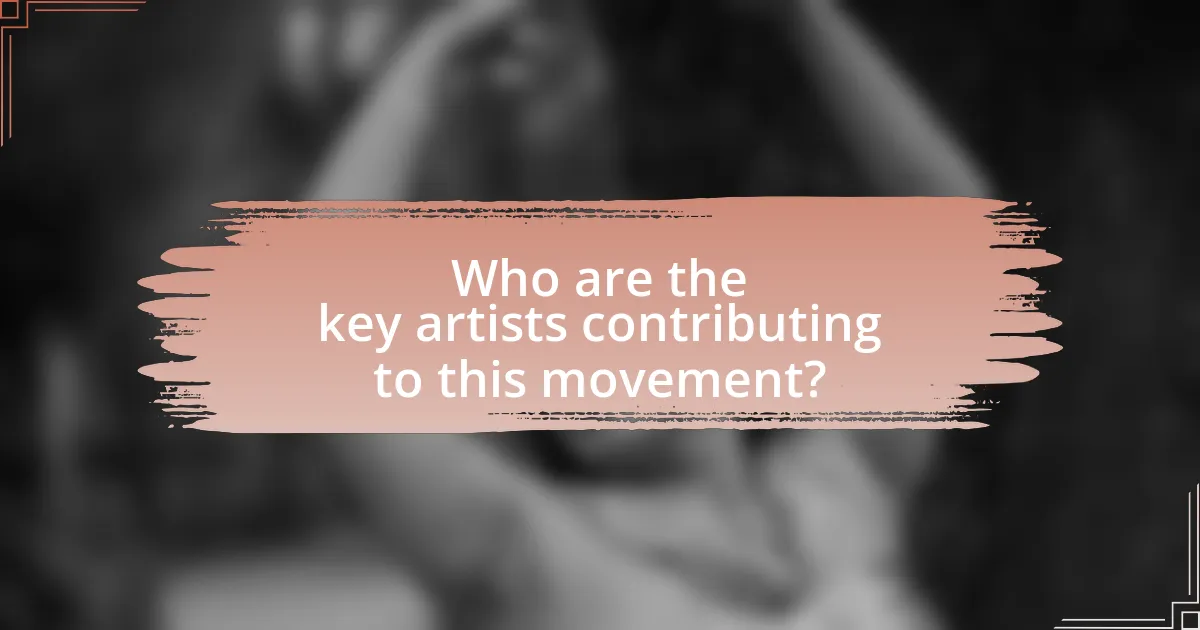
Who are the key artists contributing to this movement?
Key artists contributing to the movement “Portraits of Resilience: Artists Reflecting on Social Justice” include Kehinde Wiley, Ai Weiwei, and Carrie Mae Weems. Kehinde Wiley is renowned for his vibrant portraits that challenge traditional representations of race and identity. Ai Weiwei uses his art to address human rights issues and social injustices, often incorporating political themes into his work. Carrie Mae Weems focuses on the intersection of race, gender, and class, using photography and video to explore the complexities of identity and social justice. These artists exemplify the movement’s commitment to reflecting and advocating for social change through their impactful art.
What backgrounds do these artists come from?
The artists featured in “Portraits of Resilience: Artists Reflecting on Social Justice” come from diverse backgrounds, including various ethnicities, socioeconomic statuses, and cultural experiences. Many of these artists have roots in marginalized communities, which informs their perspectives on social justice issues. For instance, artists may include individuals from African American, Latinx, Indigenous, and immigrant backgrounds, each bringing unique narratives shaped by their lived experiences and societal challenges. This diversity enhances the richness of their work, allowing for a multifaceted exploration of resilience and advocacy within the context of social justice.
How do their personal experiences shape their artistic expressions?
Personal experiences significantly shape artists’ expressions by influencing their themes, techniques, and emotional depth. For instance, artists who have faced social injustices often channel their experiences into their work, creating pieces that reflect their struggles and resilience. This is evident in the works of artists like Kerry James Marshall, whose paintings address African American identity and history, drawing from his own experiences growing up in a racially segregated environment. Such personal narratives not only inform the subject matter but also evoke empathy and provoke thought among viewers, making the art a powerful medium for social commentary.
What influences do they draw from their cultural heritage?
Artists reflecting on social justice draw influences from their cultural heritage through themes of identity, history, and community. These influences manifest in their work as they explore personal and collective narratives shaped by their backgrounds. For instance, artists may incorporate traditional symbols, storytelling techniques, or historical references that resonate with their cultural experiences, thereby fostering a deeper understanding of social issues. This connection to cultural heritage not only enriches their artistic expression but also serves as a platform for advocating social change, as seen in movements like the Chicano art movement, which highlights the struggles and resilience of Mexican-Americans.
Which notable works exemplify this theme?
Notable works that exemplify the theme of “Portraits of Resilience: Artists Reflecting on Social Justice” include “The Dinner Party” by Judy Chicago, which addresses women’s history and contributions, and “The Migration Series” by Jacob Lawrence, depicting the African American experience during the Great Migration. These works highlight social justice issues through their artistic narratives and visual storytelling, showcasing resilience in the face of adversity.
What are the stories behind these significant pieces?
The stories behind significant pieces in “Portraits of Resilience: Artists Reflecting on Social Justice” often center on the artists’ personal experiences and societal issues they aim to address. For instance, many artists draw inspiration from historical injustices, such as systemic racism or gender inequality, using their work to highlight these struggles and advocate for change. Specific pieces may depict real-life events, such as protests or movements, capturing the emotions and resilience of marginalized communities. The artists often incorporate elements from their own backgrounds, making the artwork a reflection of both personal and collective narratives. This connection to real-world issues is evidenced by the artists’ statements and the context in which the pieces were created, reinforcing the importance of art as a medium for social commentary and activism.
How have these works impacted public perception of social justice?
These works have significantly shaped public perception of social justice by highlighting systemic inequalities and fostering empathy. Artists use their platforms to convey powerful narratives that resonate with diverse audiences, making complex social issues more accessible. For instance, the widespread impact of visual art and performance in movements like Black Lives Matter has raised awareness about racial injustice, leading to increased public discourse and activism. Studies show that exposure to art addressing social issues can enhance understanding and motivate individuals to engage in social justice efforts, as evidenced by the rise in participation in protests and community initiatives following high-profile artistic expressions.
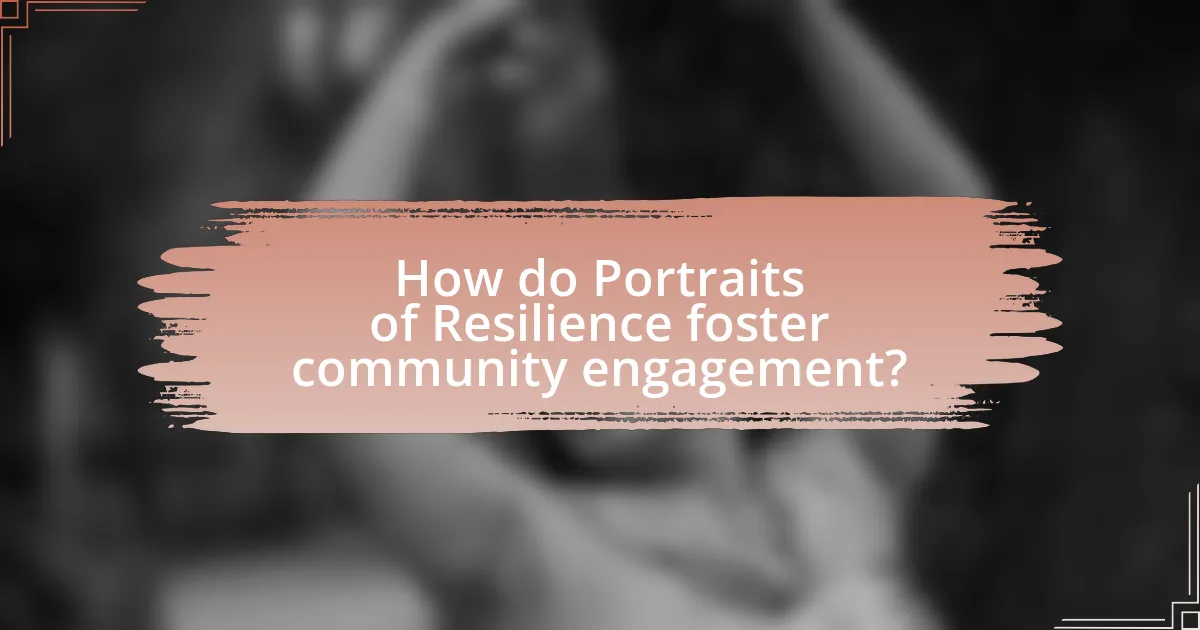
How do Portraits of Resilience foster community engagement?
Portraits of Resilience foster community engagement by visually representing the strength and perseverance of individuals within a community, thereby inspiring collective action and solidarity. These portraits often highlight personal stories of overcoming adversity, which resonate with viewers and encourage them to connect with one another through shared experiences. For instance, community art projects that feature these portraits can lead to discussions and initiatives focused on social justice issues, as seen in the “Portraits of Resilience” project in various urban areas, where local artists collaborated with residents to create works that reflect their struggles and triumphs. This engagement not only amplifies marginalized voices but also cultivates a sense of belonging and empowerment among community members, fostering a more cohesive and active community.
What role do exhibitions play in promoting social justice awareness?
Exhibitions play a crucial role in promoting social justice awareness by providing a platform for marginalized voices and highlighting systemic inequalities. Through visual art, installations, and interactive displays, exhibitions engage audiences emotionally and intellectually, fostering empathy and understanding of social justice issues. For instance, the “Portraits of Resilience” exhibition showcases artists who reflect on their experiences with injustice, thereby raising awareness about specific social issues such as racial inequality, gender discrimination, and economic disparity. This engagement is supported by research indicating that art can effectively influence public perception and inspire action, as seen in studies conducted by the National Endowment for the Arts, which demonstrate that exposure to art can lead to increased civic engagement and advocacy for social change.
How can community involvement enhance the impact of these artworks?
Community involvement can significantly enhance the impact of artworks by fostering deeper connections between the artists and the audience. When community members participate in the creation or exhibition of artworks, they contribute personal narratives and cultural perspectives that enrich the overall message. For instance, collaborative projects often lead to a more diverse representation of social issues, making the artworks more relatable and impactful. Research indicates that community-engaged art projects can increase public awareness and dialogue around social justice topics, as seen in initiatives like the “Art for Justice Fund,” which aims to address systemic inequalities through artistic expression. This involvement not only amplifies the voices of marginalized groups but also encourages collective action, thereby strengthening the artworks’ relevance and resonance within the community.
What are some successful examples of community-driven art projects?
Successful examples of community-driven art projects include the “Chicago Mural Movement,” which transformed urban spaces through collaborative murals that reflect local culture and social issues. This movement, which began in the 1970s, involved artists and community members working together to create public art that addresses themes of identity, history, and social justice. Another notable example is “The People’s Climate March,” where artists and activists collaborated to create large-scale installations and performances that raise awareness about climate change and environmental justice. These projects demonstrate the power of art to engage communities and foster dialogue around critical social issues.
How can individuals support artists focused on social justice?
Individuals can support artists focused on social justice by purchasing their artwork, attending their exhibitions, and sharing their work on social media platforms. Financially supporting artists through direct purchases or donations enables them to continue their advocacy and creative expression. Attending exhibitions not only provides exposure but also fosters community engagement around social justice themes. Sharing their work amplifies their message and reaches a broader audience, increasing awareness of social justice issues. According to a report by the National Endowment for the Arts, art can play a significant role in social change, highlighting the importance of supporting artists who address these critical topics.
What are effective ways to promote and share their work?
Effective ways to promote and share work include utilizing social media platforms, engaging in community events, and collaborating with other artists or organizations. Social media platforms like Instagram and Facebook allow artists to reach a broad audience, showcasing their work visually and interactively. Engaging in community events, such as art fairs or social justice forums, provides opportunities for direct interaction with potential audiences and supporters. Collaborating with other artists or organizations can amplify reach and create a network of shared resources and audiences. According to a study by the National Endowment for the Arts, artists who actively engage in community activities and utilize social media report higher visibility and engagement with their work.
How can art collectors contribute to the sustainability of these artists?
Art collectors can contribute to the sustainability of artists by purchasing their works, which provides financial support and stability. This financial backing enables artists to continue creating and exploring themes related to social justice, as seen in movements where art has been pivotal in raising awareness and driving change. For instance, the sale of artworks often directly funds the artist’s projects, allowing them to focus on their craft without the burden of financial insecurity. Additionally, collectors can promote artists through their networks, increasing visibility and potential sales, which further enhances the artists’ sustainability in the competitive art market.
What practical steps can artists take to address social justice through their work?
Artists can address social justice through their work by creating pieces that raise awareness about social issues, engaging in community collaborations, and using their platforms to amplify marginalized voices. For instance, artists can produce artwork that highlights systemic inequalities, such as racial injustice or economic disparity, thereby educating the public and sparking dialogue. Collaborating with local organizations or activists allows artists to ground their work in real community needs and experiences, fostering a sense of solidarity and shared purpose. Additionally, by sharing stories and perspectives from underrepresented groups, artists can challenge dominant narratives and promote inclusivity. This approach is supported by the fact that art has historically played a crucial role in social movements, as seen in the works of artists like Keith Haring and Ai Weiwei, who used their art to advocate for social change.
